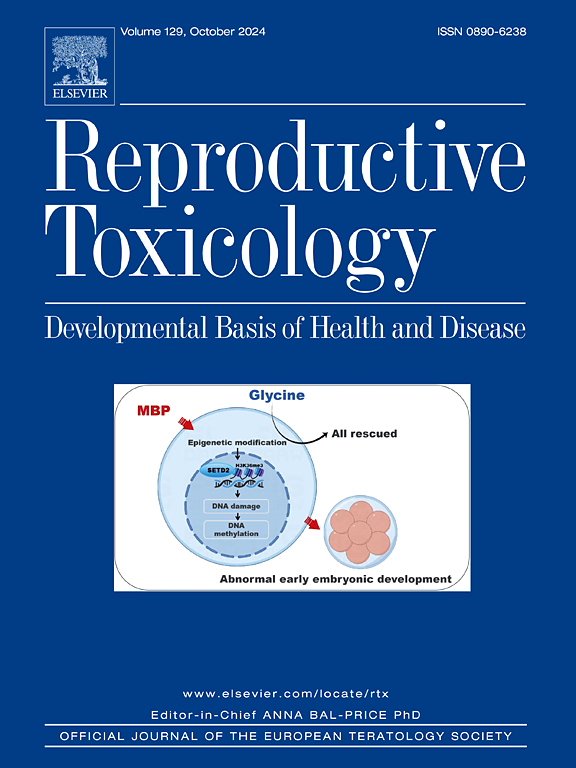人类和小鼠产前塑料邻苯二甲酸盐暴露与脂质酰基肉碱水平之间的关系。
IF 3.3
4区 医学
Q2 REPRODUCTIVE BIOLOGY
引用次数: 0
摘要
邻苯二甲酸盐是一种无处不在的环境污染物,因其干扰内分泌的特性而闻名,尤其是在怀孕和幼儿期等关键时期。邻苯二甲酸酯改变脂质代谢,但产前暴露对后代脂质组的作用尚不清楚。我们特别关注长链酰基肉碱——脂肪酸氧化的中间体,作为线粒体功能和能量代谢的潜在生物标志物。本研究旨在(1)调查产前邻苯二甲酸盐暴露与儿童血液中酰基肉碱浓度之间的关系,(2)评估产前给予邻苯二甲酸二(2-乙基己基)酯(DEHP)对小鼠后代血液、大脑和肝脏中酰基肉碱水平的影响。我们对一项前瞻性出生队列研究和一项小鼠实验研究进行了分析。从Barwon婴儿研究队列(1074对母婴)中,在妊娠36周时评估了产前邻苯二甲酸盐暴露情况,并在脐带血和6个月、12个月和4岁时的儿童血液中检测了邻苯二甲酸盐暴露与酰基肉碱水平的关系。在小鼠实验中,C57BL/6J孕鼠在妊娠中期暴露于20μg/kg DEHP 5天,并在出生后1月龄时对子代组织进行酰基肉碱谱分析。我们的研究结果表明,产前邻苯二甲酸酯水平(特别是邻苯二甲酸丁苯酯(BBzP)和邻苯二甲酸二异丁酯(DiBP))与出生时人类脐带血中总长链酰基肉碱水平呈负相关。相比之下,12月龄时,BBzP与长链酰基肉碱呈正相关。在小鼠中,产前DEHP暴露仅5天就会导致大脑和肝脏中棕榈酰肉碱(AC16:0)水平下降,但血液中没有。综上所述,我们的研究结果强调,产前邻苯二甲酸盐暴露可以改变酰基肉碱谱,表明脂肪酸代谢的中断可能对代谢健康产生长期影响。本文章由计算机程序翻译,如有差异,请以英文原文为准。
The associations between prenatal plastic phthalate exposure and lipid acylcarnitine levels in humans and mice
Phthalates are ubiquitous environmental pollutants known for their endocrine-disrupting properties, particularly during critical periods such as pregnancy and early childhood. Phthalates alter lipid metabolism, but the role of prenatal exposure on the offspring lipidome is less understood. In particular, we focused on long chain acylcarnitines - intermediates of fatty acid oxidation that serve as potential biomarkers of mitochondrial function and energy metabolism. This study aimed (i) to investigate the association between prenatal phthalate exposure and the child’s blood acylcarnitine concentrations and, (ii) to evaluate the impact of prenatal administration of di-(2-ethylhexyl) phthalate (DEHP) on acylcarnitine levels in mouse offspring blood, brain and liver. We conducted analyses of both a prospective birth cohort study and an experimental study in mice. From the Barwon Infant Study cohort (1074 mother-child pairs), prenatal phthalate exposure was assessed at 36 weeks' gestation and its association with acylcarnitine levels was examined in cord blood, and child’s blood at 6 months, 12 months and 4 years. In mice, pregnant C57BL/6 J mouse dams were exposed to 20 μg/kg DEHP for 5 days mid-gestation, and offspring tissues were analyzed at 1 month of age postnatally for acylcarnitine profiles. Our findings demonstrate that prenatal phthalate levels (specifically butyl benzyl phthalate (BBzP) and diisobutyl phthalate (DiBP)) are inversely associated with total long chain acylcarnitine levels in human cord blood at birth. In contrast, BBzP was positively associated with the long chain acylcarnitines at 12 months of age. In mice, prenatal DEHP exposure for only 5 days led to decreased palmitoylcarnitine (AC16:0) levels in the brain and liver, but not in blood. Taken together, our findings highlight that prenatal phthalate exposure can alter acylcarnitine profiles, indicating disruptions in fatty acid metabolism that may have long-term effects on metabolic health.
求助全文
通过发布文献求助,成功后即可免费获取论文全文。
去求助
来源期刊

Reproductive toxicology
生物-毒理学
CiteScore
6.50
自引率
3.00%
发文量
131
审稿时长
45 days
期刊介绍:
Drawing from a large number of disciplines, Reproductive Toxicology publishes timely, original research on the influence of chemical and physical agents on reproduction. Written by and for obstetricians, pediatricians, embryologists, teratologists, geneticists, toxicologists, andrologists, and others interested in detecting potential reproductive hazards, the journal is a forum for communication among researchers and practitioners. Articles focus on the application of in vitro, animal and clinical research to the practice of clinical medicine.
All aspects of reproduction are within the scope of Reproductive Toxicology, including the formation and maturation of male and female gametes, sexual function, the events surrounding the fusion of gametes and the development of the fertilized ovum, nourishment and transport of the conceptus within the genital tract, implantation, embryogenesis, intrauterine growth, placentation and placental function, parturition, lactation and neonatal survival. Adverse reproductive effects in males will be considered as significant as adverse effects occurring in females. To provide a balanced presentation of approaches, equal emphasis will be given to clinical and animal or in vitro work. Typical end points that will be studied by contributors include infertility, sexual dysfunction, spontaneous abortion, malformations, abnormal histogenesis, stillbirth, intrauterine growth retardation, prematurity, behavioral abnormalities, and perinatal mortality.
 求助内容:
求助内容: 应助结果提醒方式:
应助结果提醒方式:


